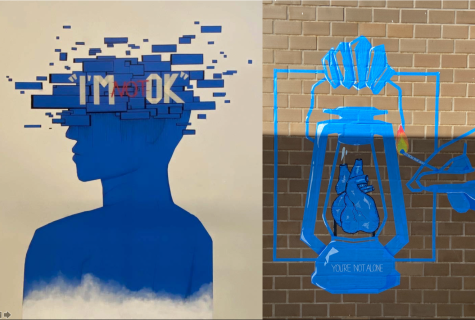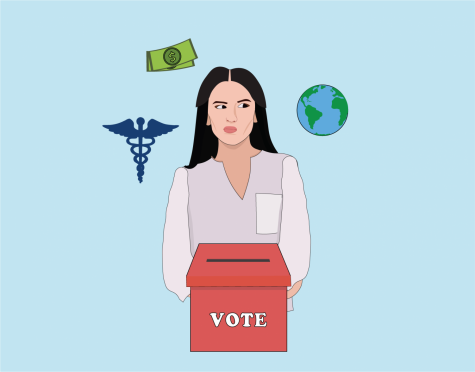Report raises questions CollegeBoard can’t answer
- College Board’s most recently released Form 990 reveals staggering profits, employee compensation and even ‘housing allowances’ for a company that considers itself a 501(c)(3) nonprofit.
The sound of buzzing was nearly deafening on Apr. 15. The Commons was filled beyond capacity with hundreds of students pushing their way in to find seats. Lucky students found vacant chairs, but dozens sat against the wall so they could see the PowerPoint on the screen.
Up by the projector, Assistant Principal Dave Kravitz attempted to direct the mass of unruly students. They were all there to fill out mandatory information required by the College Board to properly identify their AP tests. Some students were listening, but most ignored the slide-by-slide directives and began to fill out forms they had seen before — by now seniors had been through the process three or four times.
It was a scene of striking inefficiency for a test that Dougherty charges $125 a pop for students to take. But what is perhaps more surprising than the fact that the College Board only charges students a suggested amount of $91 is that the College Board maintains its status as a nonprofit.
College Board’s most recently released Form 990 reveals staggering profits, employee compensation and even ‘housing allowances’ for a company that considers itself a 501(c)(3) nonprofit.
The Form 990, which is taken from the 2012 fiscal year, admits to $55,255,917 in “Revenue less expenses”, or profit. 674 employees received more than $100,000 in compensation from the College Board, with former CEO Gaston Caperton earning an astounding $1,789,882 that year in total compensation.
There is nothing wrong with the lead executive of a successful nonprofit earning a substantial salary. The problem comes in what a nonprofit has built its success on. College Board maintains in its mission statement that its primary goals “are to improve college and career readiness and increase access to opportunity for all students through rigorous instruction and assessment programs.” But does a company that earns $351,949,064 of its revenue from “AP and AP instruction” truly have its students’ best interests at heart?
Additionally, the use of funds for lobbying and personal expenses paint the company in a suspicious light. College Board has attempted to influence public opinion of legislative matters through paid staff/management, mailings to members/legislators/the public and “direct contact with legislators, their staffs, government officials or legislative bodies.” College Board also used funds to pay for “first class/charter travel” as well as “housing allowances/residences for personal use.”
We asked the College Board press office to comment on employee compensation, lobbying activities and suspicious investments in “Central America and the Caribbean”. They did not respond, or honor our appeal for their 2013 Form 990, which is “available upon request” according to the 2012 document.
When finally freed of filling in the most expensive bubble sheet of our high school careers, we approached DVHS principal Danny Hillman and challenged the AP test price inflation at Dougherty.
While College Board’s price recommended is $91 per AP exam, it costs Dougherty students much more per test, $125 this year, and $105 in past years.
Hillman justified that after paying College Board for the AP tests themselves, the school needs to cover administrative costs, which include additional desks and chairs and exam proctors. These costs are not covered by district or state funding, rendering the costs completely the financial responsibility of each school.
“This is the only thing we charge students for … the money doesn’t really stay with us; it goes back to AP and then we charge that little bit extra, that $20-30, so that we can facilitate the rest of the exam,” he explained.
Hillman clarified that the DVHS student price is not meant to deter exam participation, adding that there are also fee waivers for students who qualify.
When asked why the price of this year’s AP exams were raised $20 per test, Hillman credited “an increased number of tests” in terms of the volume of students taking the exams. More tables and chairs must be rented to accommodate the increase in AP participation, as well as hiring more proctors. Hillman cited AP Calculus as an example, as the number of students taking the AP exam this year exceeds the capacity of the auxiliary gym, requiring the use of two testing locations to be proctored at the same time.
Hillman adds that “strict” new College Board standards of testing conditions, such as how far students need to be away from each other during testing, also “means a higher cost for us”.
With students and school administration feeling the pressures of increasing AP exam costs, it’s worth noting that College Board, a nonprofit organization, continues to pay some of its employees six and seven figure salaries. The College Board earned over $55 million in profit, thanks to the financial efforts of schools like DVHS.
Hillman assured, “We do it for the convenience of students, but we don’t make money.”
Want to check out College Board’s 2012 990 yourself? Visit www.guidestar.org and search for College Board’s 990 to see the data for yourself.
















